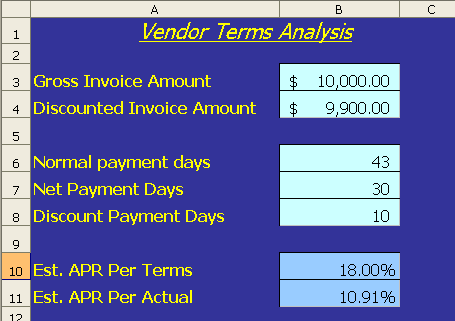You may have received an invoice from a vendor that had payment terms that offered you a choice. An example of such a payment term is 2/10 Net 30. This means that if you pay the invoice within 10 days, you can take 2% off of the invoice amount. Otherwise the entire invoice amount is due in 30 days.
Whether taking this discount and paying early is a good idea depends on your marginal borrowing rate (the interest rate you have to pay on the next dollar that you borrow). If after converting the discount into an annual percentage rate, that rate is greater than your marginal borrowing rate, you should take the discount even if you have to borrow the money to do so. It’s almost always advantageous to pay early and take the discount.
As an example, assume you’ve received an invoice for $10,000 with terms of 1/10 Net 30, or a 1% discount if you pay in 10 days.

Ten thousand is the gross invoice and the discounted amount is $9,900, or a 1% discount. There are three time periods that you need to consider. Most calculations will only use two, but don’t you fall into that trap. You need to know the number of days to pay to get the discount (10), the number of days to pay according to the terms if you don’t take the discount (30), and the number of days in which you will actually pay if you don’t take the discount (43 in this example). That last number would likely take into account your history with this vendor. If you have no history with this particular vendor, you should consider how timely you normally pay your bills. Some companies pay on time religiously, while others squeeze as much free interest out of their vendors as possible. Whatever your situation is, be sure to use accurate numbers, not idealistic ones. The formulas are:
B10: =360/(B7-B8)*((B3-B4)/B3)
B11: =360/(B6-B8)*((B3-B4)/B3)
According to the terms, the vendor is offering to borrow $10,000 from you for 20 days and pay you $100 interest. That works out to about an 18% interest rate. I think that’s what Citibank used to charge me when I was in college. In our example, though, you know that you have historically paid this vendor in an average of 43 days without incurring any late fees or other kinds of penalties. It’s reasonable to assume that you wouldn’t pay them in 30 days since you never have. You’re really not loaning them the money for 20 days (30 – 10) but 33 days (43 – 10). If you can borrow $9,900 at something less than 10%, you should do it and pay the bill early.
The other side of this coin is the consideration of the vendor, that is, the company trying to collect the bill. Why on Earth would they offer a discount of this magnitude. Payment terms of 2/10 Net 30 is pretty common and is the equivalent of about 36%. If you could make 36% on your money all day long, you could buy and sell Bill Gates and Warren Buffett. There are a couple of reasons companies would offer you this seemingly great deal.
First, they may not be able to borrow money at any interest rate. Their consideration in the above scenario is the same as yours. That is, if they can borrow money at less than 10%, they don’t need your money early and shouldn’t offer the discount at all. If however, they are maxed out and can only borrow from Vinney the loan shark, then your money is cheap (compared to broken knee caps).
Second, there’s a risk factor. The longer a receivable is outstanding, the greater a chance that it will never be collected. There is a cost to that risk, although it’s hard to quantify. “A bird in the hand” is the financial doctrine that applies and that indicates the cost is around 50%.
There’s also a risk that the customer will take the discount and still pay in 45 days. If you’re dealing with very large companies that have a tendency to dictate terms to their smaller suppliers, save yourself the trouble and don’t even offer the discount.
That’s …er…really interesting, Dick.
Hi Dick,
I think that’s a pretty nice summary for us accounting types. I wonder if it might be more useful to a non-accounting person if you added two more fields though:
-What rate can we borrow at
-Recommendation based on the which rate is lowest.
Cheers,
And who said accounting wasn’t exciting… That takes me back to my AP/AR days. Interestingly enough from my experience most small companies pay in 30 days and don’t take the discounts (dispite the fact that they have the cash flow to pay in 10 but couldn’t be bothered) because they had no idea what the effective interest rate was.
“Dick:
I found your article on vendor discounts very interesting and useful. Can you explain to a math dummy how you arrive to the 36% savings realized by taking advantage of the 2% available discount?”
CY: It’s not 36% saved, but 36% annual interest rate. 30 days normal – 10 days discount = 20 day “loan term”. 360 days in a year / 20 day loan term = 18. 18 * .02 = .36 = 36%. That is, if a bank loaned you money for 20 days and charged you 2%, you’d be paying 36% on an annual basis.
can anyone advise any link or website to calculate the APR/EPR?